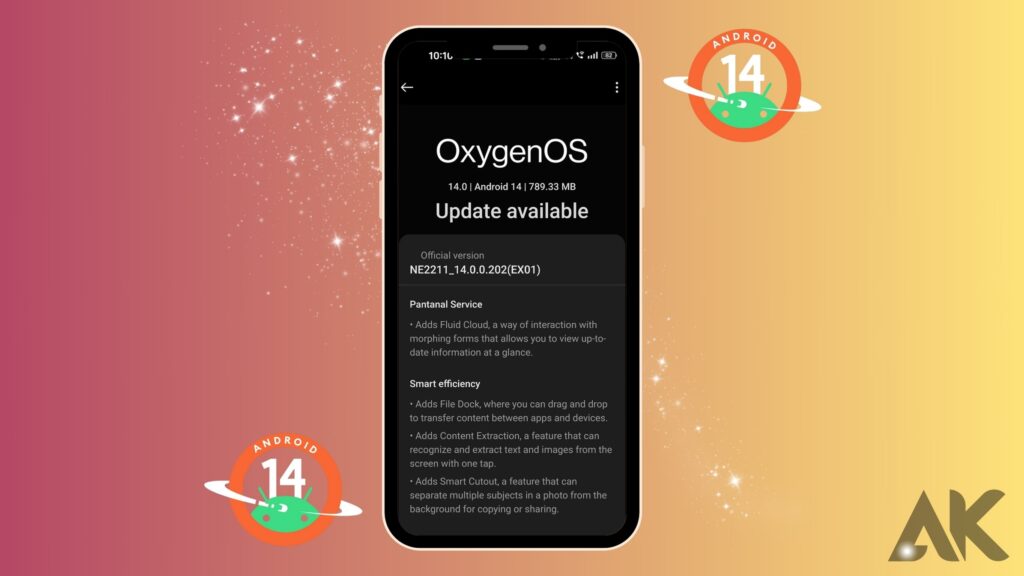Elevate your smartphone experience to unprecedented heights with the OnePlus 11R Android 14 upgrade. Seamlessly blending cutting-edge technology with unparalleled performance, this update promises to optimize your device like never before.
Embark on a journey of enhanced efficiency and speed as the OnePlus 11R Android 14 upgrade introduces a myriad of innovative features tailored to elevate your user experience.
OnePlus 11R and OnePlus 10T: What to Expect with OxygenOS 14

These two phones are going to get a lot of new features with the upgrade. Included in this are the improvements to privacy, security, and battery management that Google made to Android 14, according to Google. The OnePlus 11R will also get the latest Android Security Patch for November 2023 along with the update.
The new Aquamorphic Design 2.0 visual redevelopment, which OnePlus is bringing to OxygenOS 14, will offer the phones a fresh appearance and feel. This is something that Android upgrades have been missing for a long time.
A new proprietary software called the Trinity Engine will also help OnePlus phones on OxygenOS 14 better manage CPU and RAM optimization for a general performance boost. Other features, like the new File Dock, Security Centre, and Notes 2.0 app, are also set to make general usage more productive and intuitive. The File Dock, in particular, will help users’ OnePlus devices communicate with each other more seamlessly, enabling quick file sharing and more.
If you own a OnePlus smartphone that is not the 11R or the 10T, worry not. The update will soon be coming to a lot of other phones in the OnePlus 9, 10, and 11 series, as well as some of the Nord smartphones.
10 best features and settings

1—App-based languages:
Another app-based option is the ability to choose multiple languages for distinct applications. This is not just an OxygenOS feature, but a basic element of Android 14. For example, you may now change your phone’s language settings to run apps in other languages. To be clear, not all applications now offer this capability. However, a few of the Google apps and a few third-party apps do.
2—Unified security dashboard:
After years of being dispersed across the phone’s settings, OxygenOS 14 finally brings them all together. Private Safe, App Locker, System Cloner, and other similar tools are now accessible under security and privacy. You can also access your phone’s system updates, Google account settings, and device lock settings. Outdated applications, malware infestations, and phishing attempts are just a few of the security concerns that may be identified under the security and privacy page.
3: Carbon footprint AOD:
A new AOD screen in OxygenOS 14 promotes walking and reduces your environmental impact. What is the process? For starters, this Always-on Display (AOD) theme keeps track of how many steps you take each day and displays the resulting drop in your carbon footprint.
4—Lockscreen shortcuts:
Finally, with OxygenOS 14, you may access a feature that was severely under-received in OxygenOS 13. Aside from Google Assistant, the newest software allows you to add a plethora of shortcuts to the lock screen. You may pick between Snapchat, QR code, or none at all on our OnePlus 11, but I’ve set it to Torch.
5—App-specific refresh rate:
On older OxygenOS versions, I found it annoying that some applications would only support 60Hz, which is particularly problematic on a premium phone like the OnePlus 11, which has a 120Hz refresh rate. One positive aspect is that you can adjust the refresh rate to 120 Hz in the settings for almost any program. This means that with OxygenOS 14, you can force applications that didn’t support 120Hz mode in OxygenOS 13 to function in 120Hz mode.
6—Smart Cutout:
Users of the iPhone could capture a picture cutout by just holding down an image for some time now. You can access the gallery app in OxygenOS 14, exactly as on iOS. To make a cutout, exactly as on an iPhone, you need to long-press on the picture. Even if it’s not completely novel, Smart Cutout is a great addition.
7—Auto-pixelate 2.0:
Hit the edit button to automatically pixelate any sensitive information in a picture or screenshot using the Auto-Pixelate option, which is just one additional image-related feature. To utilize the auto-pixelate feature, just snap a picture or screenshot, press edit, and then touch Pixelate. With that out of the way, 95% of the time, this function is perfect, and the other 5%, you can always manually touch an area to conceal critical information.
8—OxygenOS dynamic island:
The dynamic island has been helpful ever since the release of the iPhone 14 Pro, whether you like it or not. Even if several Android developers have attempted to include features along these lines, the one in OxygenOS 14 is, without a doubt, the greatest. While there isn’t a specific configuration that will activate it, several examples include a Swiggy order, a device linked to your phone’s hotspot, or the activation of a timer. You can interact with this pill by long-pressing on it, and it’s displayed right up there.
9—Global Search:
With the release of OxygenOS 14, built on Android 14, we now have the greatest global search available on any Android phone, ever. Spotlight, also known as global search, is a basic yet perhaps the most useful iOS feature that iPhone users have enjoyed for quite some time. Going into your home screen’s settings and selecting Global Search from the drop-down menu is, of course, always an option. This option has been available since OxygenOS 13; however, it is no longer necessary to activate. You see, the most recent OxygenOS 14 has a search button on the home screen by default. With just one touch, you’ll be taken to OxygenOS 14’s Global Search.
10—File Dock:
You may copy and paste any text, picture, link, or file to the File Dock using the File Dock feature, which is an extension of the Smart Sidebar in OxygenOS 13. To save a file or link in the File Dock, just drag and drop it. Then, you may use it in the appropriate app or elsewhere it’s supported.
Conclusion
The OnePlus 11R’s Android 14 upgrade offers a range of innovative features to enhance the user experience. The update introduces Google’s additions to Android 14, such as better privacy and security features and better battery management. The OnePlus 11R will also receive the November 2023 Android Security Patch. OxygenOS 14 features include the new Aquamorphic Design 2.0 visual revamp, proprietary software called the Trinity Engine, and the new File Dock, Security Centre, and Notes 2.0 apps.
The update will soon be available to other OnePlus phones in the OnePlus 9, 10, and 11 series, as well as some of the Nord smartphones. Key features include app-based languages, a unified security dashboard, a carbon footprint AOD screen, lock screen shortcuts, an app-specific refresh rate, smart cutout, auto-pixelate 2.0, OxygenOS dynamic island, global search, and File Dock. These features aim to make the user experience more efficient and intuitive, enhancing efficiency and speed on the OnePlus 11R and OnePlus 10T.
FAQS
Does the OnePlus 11R get Android 14?
Additionally, the most recent Oxygen OS 14 upgrade has begun to be distributed across the company’s existing flagship phone portfolio. In India, it has moved on from the OnePlus 11 and 10 Pro to the OnePlus 11R, 10T, and Nord 3. With this upgrade, OnePlus phones now have the most recent version of Android, 14.
Will the OnePlus 11R get Android 16?
Out of the box, the OnePlus 11R comes with OxygenOS 13, which is based on Android 13. From now until 2025, the OnePlus 11R will be receiving software upgrades, the most recent of which is Android 16. In addition, it will continue to get software fixes for an additional year, all the way until 2026

